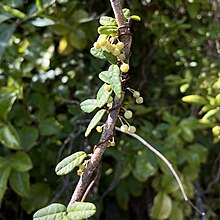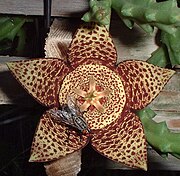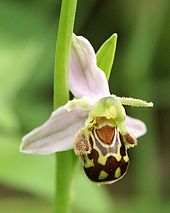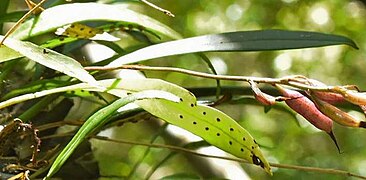Mimicry in plants

In evolutionary biology, mimicry in plants is where a plant evolves to resemble another organism physically or chemically. Mimicry in plants has been studied far less than mimicry in animals, with fewer documented cases and peer-reviewed studies. It may provide protection against herbivory, or may deceptively encourage mutualists, like pollinators, to provide a service without offering a reward in return.[2]
Types of plant mimicry include Bakerian, where female flowers imitate males of the same species; Dodsonian, where a plant mimics a rewarding flower, luring pollinators by mimicking another species of flower, or fruit where feeders of the other species are attracted to a fake fruit to distribute seeds; Vavilovian, where a weed is unintentionally artificially selected to resemble a crop plant; Pouyannian, in which a flower imitates a female mate, deceiving a male pollinating insect into pseudocopulation; Batesian, where a harmless species deter predators by mimicking the characteristics of a harmful species; and leaf mimicry, where a plant resembles a nearby plant to evade the attention of herbivores.
Introduction
Mimicry is an adaptation by a species, called the mimic, making it resemble something else, called the model, with the effect of deceiving another species, the dupe. The three are not always all distinct, as mimicry can for example be within a species.[3] The adaptation is to the evolutionary advantage of the mimic. As such it can be any mechanism that may evolve by natural selection; no conscious intention is involved. There is no essential difference between the evolution of mimicry in plants and in other organisms such as in animals, though mimicry in animals is better known. Plant mimicry can broadly be divided into reproductive mimicry that deceives pollinators into providing their service without rewarding them in return, and protective mimicry that deceives herbivores into not eating the plant.[2]
Mimicry, including the Batesian[4] and Müllerian[5] mechanisms, was described in animals in the 19th century.[3] Charles Darwin's 1862 book Fertilisation of Orchids laid the foundations for research into plant reproductive strategies co-evolved with insects. In the book, Darwin wonders why some orchids apparently mimic bees, and how orchids without nectar succeed in attracting pollinators.[6] Several mimicry mechanisms in plants were described in the 20th century, starting with Pouyannian (1916),[7] Vavilovian (1951),[8] and Gilbertian (1975).[9] Study of mimicry in plants broadened in the 21st century, with the discovery of Batesian mimicry in plants in 2003,[10] and crypsis or leaf mimicry in 2014.[1]
Reproductive
Brood-site deception

Carrion flowers, including the enormous Amorphophallus titanum,[12] mimic the scent and appearance of rotting flesh to attract necrophagous (carrion-feeding) insects like flesh flies (Sarcophagidae), blowflies (Calliphoridae), house flies (Muscidae) and some beetles (e.g., Dermestidae and Silphidae) which search for dead animals to use as brood sites.[11][13] The decaying smell of the flower comes from oligosulfides, compounds found in decayed proteins with the sulfur-containing amino acids methionine and cysteine. While carrion flowers do produce a small amount of nectar, this does not necessarily make their relationship to necrophagous insects mutualistic. Insects lay eggs on the carrion flowers, meaning they mistake the flowers for oviposition sites. The nectar acts as a lure to bring the insects closer to the reproductive parts of the flower.[11]
Bakerian
Bakerian mimicry, named after English naturalist Herbert Baker,[14] is a form of automimicry or intraspecific mimicry that occurs within a single species. In plants, the female flowers mimic male flowers of their own species, cheating pollinators out of a reward. This reproductive mimicry may not be readily apparent as members of the same species may still exhibit some degree of sexual dimorphism, i.e. the phenotypic difference between males and females of the same species. It is common in many species of Caricaceae, a family of flowering plants in the order Brassicales, found primarily in tropical regions of Central and South America, and Africa.[15][16]
Dodsonian
Dodsonian mimicry, named after the American botanist Calaway H. Dodson, is a form of reproductive floral mimicry where the model belongs to a different species than the mimic. By providing similar sensory signals to the model's flowers, the mimic lures the model's pollinators. Like Bakerian mimics, no nectar is provided.[17]
Epidendrum ibaguense, a species of epiphytic orchid of the genus Epidendrum that occurs in the northern part of South America, resembles flowers of Lantana camara and Asclepias curassavica. Epidendrum ibaguense is pollinated by monarch butterfly (Danaus plexippus) and perhaps hummingbirds.[18] Similar cases are seen in some other species of the same family. The mimetic species may still have pollinators of its own; for example, a Lamellicorn beetle helps to pollinate Ophrys species mainly pollinated by bees.[19]
Pouyannian

In Pouyannian mimicry,[20][7] named after the French lawyer and amateur botanist Maurice-Alexandre Pouyanne,[21] flowers mimic a male pollinator's potential female mate, visually or with other stimuli.[22] Many orchids, including the Ophrys bee orchids, deceive male insects into pseudocopulation in this way, using them to transfer pollen.[23] For instance, the orchid Epipactis helleborine is physiologically and morphologically adapted to attract social wasps as their primary pollinators. Social wasps feed their larvae on insects such as caterpillars. To locate that prey, they use a combination of visual and olfactory cues. The flowers of E. helleborine and E. purpurata emit green-leaf volatiles attractive to foragers of the social wasps Vespula germanica and V. vulgaris. Several E. helleborine green-leaf volatiles that induce a response in the antennae of wasps are also emitted by cabbage leaves infested with caterpillars (Pieris brassicae), common prey items for wasps. Despite a large nectar reward, the species is almost entirely overlooked by other pollinators.[24]
Defensive
Batesian
In Batesian mimicry, named after the English naturalist Henry Walter Bates, a harmless species has evolved to imitate the warning signals of a harmful species directed at a predator. Batesian mimicry of thorns[10] and possibly of spider webs[25] has been observed in plants.
Thorn mimicry of two types has been observed in plants. The first, a special case of intra-organismic Batesian mimicry characteristic of Aloe species (Liliaceae), Washingtonia filifera (Arecaceae), and dozens of species of Agave, including A. applanta, A. salmiana, and A. obscura. These plants develop thorn-like imprints or colorations on the face of their leaves due to the teeth along the margins of that leaf (or another leaf) pressing sustained indentations into the flesh of the non-spiny parts. The second type of thorn mimicry, a more classic case of Batesian mimicry, involves the pointed, colorful organs like buds, leaves and fruit of mimetic plant species that mimic warning-coloured aposematic colorful thorns not found anywhere else in the organism.[10]
Several plants from different parts of the world may be mimics of spider webs. Dense, white trichomes are produced on newly extended stems and leaves that deter herbivory due to predatory habit or toxicity. This may be a case of visual mimicry or perceptual exploitation. Case examples include the new buds of Onopordum from Israel, Carthamus species from Greece, flower heads of Arctium tomentosum from Estonia, a fledgling leaf of Tussilago farfara from Estonia, and new fronds of Osmunda japonica from Japan.[25]
Another plant leaf pattern has been suggested to be mimetic: irregular white blotches on leaves of plants such as Pulmonaria officinalis perhaps protect against large herbivores through their resemblance to bird droppings, which could be avoided as possible sources of disease.[2]
-
![Plants such as Onopordum have dense white trichomes, which may offer protection from herbivory through their resemblance to spider webs.[25]](//upload.wikimedia.org/wikipedia/commons/thumb/9/99/Onopordum_bracteatum0.jpg/240px-Onopordum_bracteatum0.jpg)
-
![Leaves of plants such as Pulmonaria officinalis have irregular white blotches that may look like bird droppings to herbivores.[2]](//upload.wikimedia.org/wikipedia/commons/thumb/0/07/Pulmonaria_officinalis_124245650.jpg/270px-Pulmonaria_officinalis_124245650.jpg) Leaves of plants such as Pulmonaria officinalis have irregular white blotches that may look like bird droppings to herbivores.[2]
Leaves of plants such as Pulmonaria officinalis have irregular white blotches that may look like bird droppings to herbivores.[2]
Gilbertian
Gilbertian[26] or colonisation mimicry[2] is bipolar, involving only two species. The potential host (or prey) drives away its parasite (or predator) by mimicking it, the reverse of host–parasite aggressive mimicry. Georges Pasteur named it after the American ecologist Lawrence E. Gilbert [nl], who described it in 1975.[26][9] The classical instance of Gilbertian mimicry is in the plant genus Passiflora, which is grazed by the micropredator larvae of some Heliconius butterflies. The host plants have evolved stipules, small outgrowths at the base of each leaf, that mimic mature Heliconius eggs near the point of hatching. The butterflies avoid laying eggs near existing ones, reducing intraspecific competition between caterpillars, which are also cannibalistic, so those that lay on vacant leaves provide their offspring with a greater chance of survival. The stipules thus appear to have evolved as Gilbertian mimics of butterfly eggs, under selection pressure from these caterpillars.[26][27]
- Some Passiflora flower species use Gilbertian mimicry, defending against being eaten by larvae of Heliconius butterflies with leaf stipules (not shown) that resemble the butterfly's eggs.[3][28]
-
 Butterfly egg mimicry in the orchid Bulbophyllum scabratum
Butterfly egg mimicry in the orchid Bulbophyllum scabratum
Crypsis
In ecology, crypsis is an organism's ability to avoid detection by other organisms. In cryptic mimicry, a prey organism deceives a potential predator by providing false, usually visual, signals or a lack of signals, with the effect of camouflaging itself. Boquila trifoliata, a South American member of the family Lardizabalaceae, is a climbing vine with a highly variable appearance (phenotype). It is capable of mimicking the leaf features of plant species that it clings to, such as their coloration, size, and shape. By camouflaging its leaves, Boquila reduces damage from herbivorous animals.[1] It has been speculated that such plants may make use of "some kind of vision" using ocelli, or "delicate chemical sensing", to account for the mimic's ability to cope with such a large number of variables in its model's appearance.[29] Another plant that could well be a cryptic mimic of its host is the parasitic Australian mistletoe, Amyema cambagei, which has an "uncanny resemblance" to the foliage of Casuarina trees.[2]
Some hundreds of species in the Mesembryanthemaceae (ice plants) of Southern Africa are camouflaged as small stones, especially Lithops, which are known as pebble plants or living stones. By appearing non-living, they are less likely to be eaten by herbivores, and in dusty dry conditions among stones are extremely difficult to detect.[12]
-
 The epiphytic parasite Amyema cambagei (center) has foliage closely resembling that of its host, here Casuarina equisetifolia.
The epiphytic parasite Amyema cambagei (center) has foliage closely resembling that of its host, here Casuarina equisetifolia. -
 The cryptic Lithops salicola, a pebble plant, camouflaged as small stones
The cryptic Lithops salicola, a pebble plant, camouflaged as small stones
In cultivation
Vavilovian
Vavilovian mimicry (also known as crop mimicry or weed mimicry[30]) is named after the Russian plant geneticist who identified the centres of origin of cultivated plants, Nikolai Vavilov.[8] It is a form of mimicry in plants where a weed comes to share one or more characteristics with a domesticated plant through generations of artificial selection. Selection against the weed may occur by killing a young or adult weed, separating its seeds from those of the crop (winnowing), or both. This has been done manually since Neolithic times, and in more recent years by agricultural machinery.[31]
In popular culture
Darwin's open questions about orchid fertilisation stimulated popularizers such as Grant Allen to write on the topic, and led the science fiction writer H. G. Wells to tell a tale of killer orchids, his 1896 "The Flowering of the Strange Orchid". The vampire-like plant attacks people using "tentacle-like aerial rootlets". Other authors followed with similar tales of their own.[6][32]
See also
References
- ^ a b c Gianoli & Carrasco-Urra 2014.
- ^ a b c d e f Pannell & Farmer 2016.
- ^ a b c Pasteur 1982.
- ^ Bates 1862.
- ^ Müller 1878.
- ^ a b Endersby 2016, pp. 205–229.
- ^ a b Correvon & Pouyanne 1916.
- ^ a b Vavilov 1951, pp. 1–366.
- ^ a b Gilbert 1975, pp. 210–240.
- ^ a b c Lev-Yadun 2003.
- ^ a b c Johnson 2016.
- ^ a b Barrett 1983.
- ^ Urru, Stensmyr & Hansson 2011.
- ^ Barrett 2001.
- ^ Baker 1976, pp. 161–169.
- ^ Bawa 1980, pp. 467–474.
- ^ Dodson & Frymire 1961, pp. 133–139.
- ^ Boyden 1980, pp. 135–136.
- ^ Kullenberg 1961, pp. 1–340.
- ^ Pasteur 1982, p. 169.
- ^ South Coast Orchid Society 2021.
- ^ van der Pijl & Dodson 1966, pp. 129–141.
- ^ Schiestl 2005.
- ^ Brodmann et al. 2008.
- ^ a b c Yamazaki & Lev-Yadun 2015.
- ^ a b c Pasteur 1982, p. 186.
- ^ Campbell 1996, Chapter 50.
- ^ Campbell 1996.
- ^ Baluška & Mancuso 2021, p. 20190760.
- ^ McElroy 2014, pp. 207–216.
- ^ Pasteur 1982, p. 169–199.
- ^ Sánchez-Verdejo Pérez & Poveda Arias 2023, pp. 21–43.
Sources
- Baker, Herbert G. (1976). ""Mistake" pollination as a reproductive system with special reference to the Caricaceae". In Burley, J.; Styles, B. T. (eds.). Tropical Trees: Variation, Breeding, and Conservation of Tropical Trees. London; New York: Academic Press for the Linnean Society of London. pp. 161–169. OCLC 2565215.
- Baluška, František; Mancuso, Stefano (2021-03-29). "Individuality, self and sociality of vascular plants". Philosophical Transactions of the Royal Society B: Biological Sciences. 376 (1821): 20190760. doi:10.1098/rstb.2019.0760. PMC 7934911. PMID 33550947.
- Barrett, S. (1983). "Mimicry in Plants" (PDF). Scientific American. No. 257. pp. 76–83. Archived from the original (PDF) on 6 July 2024.
- Barrett, S.C.H. (2001). "The Baker and Stebbins era comes to a close". Evolution. 55 (11): 2371–2374. doi:10.1554/0014-3820(2001)055[2371:tbasec]2.0.co;2.
- Bates, Henry W. (1862). "Contributions to an insect fauna of the Amazon valley. Lepidoptera: Heliconidae". Transactions of the Linnean Society. 23 (3): 495–566. doi:10.1111/j.1096-3642.1860.tb00146.x.
- Bawa, K. S. (May 1980). "Mimicry of Male by Female Flowers and Intrasexual Competition for Pollinators in Jacaratia dolichaula (D. Smith) Woodson (Caricaceae)". Evolution. 34 (3): 467–474. doi:10.2307/2408216. JSTOR 2408216. PMID 28568703.
- Boyden, Thomas C. (January 1980). "Floral Mimicry by Epidendrum ibaguense (Orchidaceae) in Panama". Evolution. 34 (1): 135–136. doi:10.2307/2408322. JSTOR 2408322. PMID 28563205.
- Brodmann, Jennifer; Twele, Robert; Francke, Wittko; Hölzler, Gerald; Zhang, Qing-He; Ayasse, Manfred (2008-05-20). "Orchids Mimic Green-Leaf Volatiles to Attract Prey-Hunting Wasps for Pollination". Current Biology. 18 (10): 740–744. doi:10.1016/j.cub.2008.04.040. PMID 18472423.
- Campbell, N. A. (1996). Biology (4th ed.). Benjamin Cummings. Chapter 50. ISBN 0-8053-1957-3.
- Correvon, Henry; Pouyanne, Maurice-Alexandre (1916). "Un curieux cas de mimétisme chez les orchidées". Journal de la Société Nationale d'Horticulture de France (in French). 4: 29–47.
- Dodson, Calaway H.; Frymire, G. P. (1961). "Natural Pollination of Orchids" (PDF). Missouri Botanical Garden Bulletin. 49 (9): 133–152. OCLC 604064774.
- Endersby, Jim (2016). "Deceived by orchids: sex, science, fiction and Darwin". The British Journal for the History of Science. 49 (2): 205–229. doi:10.1017/S0007087416000352.
- Gianoli, Ernesto; Carrasco-Urra, Fernando (2014-05-05). "Leaf Mimicry in a Climbing Plant Protects against Herbivory". Current Biology. 24 (9): 984–987. doi:10.1016/j.cub.2014.03.010. PMID 24768053.
- Gilbert, Lawrence E. (1975). "Ecological consequences of a coevolved mutualism between butterflies and plants". In L. E. Gilbert; P. H. Raven (eds.). Coevolution of Animals and Plants. University of Texas Press. pp. 210–240. OCLC 636384400.
- Johnson, Steven D. (2016-07-11). "Carrion flowers". Current Biology. 26 (13): R556–R558. doi:10.1016/j.cub.2015.07.047. PMID 27404246.</ref>
- Kullenberg, Bertil (1961). "Studies in Ophrys Pollination". Zoologiska Bidrag Från Uppsala. 34: 1–340. OCLC 7847789.
- Lev-Yadun, Simcha (2003-09-21). "Weapon (thorn) automimicry and mimicry of aposematic colorful thorns in plants". Journal of Theoretical Biology. 224 (2): 183–188. doi:10.1016/S0022-5193(03)00156-5. PMID 12927525.
- McElroy, J. Scott (2014). "Vavilovian Mimicry: Nikolai Vavilov and His Little-Known Impact on Weed Science". Weed Science. 62 (2): 207–216. doi:10.1614/WS-D-13-00122.1. ISSN 0043-1745.
- Müller, Fritz (1878). "Ueber die Vortheile der Mimicry bei Schmetterlingen" [On the Advantages of Mimicry in Butterflies]. Zoologischer Anzeiger (in German). 1: 54–55.
- Pannell, John R.; Farmer, Edward E. (2016-09-12). "Mimicry in plants". Current Biology. 26 (17): R784–R785. doi:10.1016/j.cub.2016.04.005. PMID 27623255.
- Pasteur, Georges (1982). "A Classificatory Review of Mimicry Systems". Annual Review of Ecology and Systematics. 13: 169. doi:10.1146/annurev.es.13.110182.001125. JSTOR 2097066.
- van der Pijl, Leendert; Dodson, Calaway H. (1966). "Chapter 11: Mimicry and Deception". Orchid Flowers: Their Pollination and Evolution. Coral Gables: University of Miami Press. pp. 129–141. ISBN 978-0-87024-069-0. OCLC 310489511.
- Sánchez-Verdejo Pérez, Francisco Javier; Poveda Arias, Jorge (2023-06-15). "'The Flowering Of The Strange Orchid': From Plant Science To Victorian Horror From a Multidisciplinary Approach". Brumal. Revista de investigación sobre lo Fantástico. 11 (1): 21–43. doi:10.5565/rev/brumal.960.
- Schiestl, F. P. (2005). "On the success of a swindle: pollination by deception in orchids" (PDF). Naturwissenschaften. 92 (6): 255–264. Bibcode:2005NW.....92..255S. doi:10.1007/s00114-005-0636-y. hdl:20.500.11850/32223. PMID 15931514. S2CID 24626163.
- South Coast Orchid Society (April 2021). "Orchids Today and Yesterday". South Coast Orchid Society. Retrieved 5 August 2024.
- Urru, Isabella; Stensmyr, Marcus C.; Hansson, Bill S. (2011). "Pollination by brood-site deception". Phytochemistry. 72 (13): 1655–1666. doi:10.1016/j.phytochem.2011.02.014.
- Vavilov, Nikolai I. (1951) [1949–1950]. "The Origin, Variation, Immunity, and Breeding of Cultivated Plants". Chronica Botanica (13). Translated by K. S. Chester: 1–366. OCLC 608036378.
- Yamazaki, Kazuo; Lev-Yadun, Simcha (2015-01-07). "Dense white trichome production by plants as possible mimicry of arthropod silk or fungal hyphae that deter herbivory". Journal of Theoretical Biology. 364: 1–6. doi:10.1016/j.jtbi.2014.08.045. PMID 25193285.
- v
- t
- e

- Bakerian
- Dodsonian
- Gilbertian
- Pouyannian (with pseudocopulation)
- Vavilovian
- Anti-predator adaptation
- Animal communication
- Aposematism
- Camouflage/Crypsis
- Co-evolution
- Animal coloration
- Community ecology
- Coloration evidence for natural selection
- Dazzled and Deceived
- Deception in animals
- Deimatic behaviour
- Mimicry#Evolution
- Evolutionary ecology
- Frequency-dependent selection
- Phagomimicry
- Polymorphism
- Signalling theory
- Underwater camouflage
-
 Category mimicry
Category mimicry
![Plants such as Onopordum have dense white trichomes, which may offer protection from herbivory through their resemblance to spider webs.[25]](http://upload.wikimedia.org/wikipedia/commons/thumb/9/99/Onopordum_bracteatum0.jpg/240px-Onopordum_bracteatum0.jpg)
![Leaves of plants such as Pulmonaria officinalis have irregular white blotches that may look like bird droppings to herbivores.[2]](http://upload.wikimedia.org/wikipedia/commons/thumb/0/07/Pulmonaria_officinalis_124245650.jpg/270px-Pulmonaria_officinalis_124245650.jpg)















